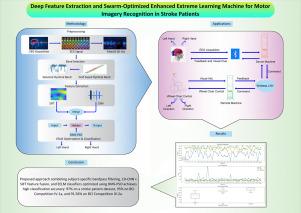基于深度特征提取和群优化的增强极限学习机的脑卒中患者运动图像识别
IF 2.3
4区 医学
Q2 BIOCHEMICAL RESEARCH METHODS
引用次数: 0
摘要
背景:在脑机接口(BCI)应用中,运动图像(MI)的解释很大程度上是由脑电图(EEG)信号的使用驱动的。然而,由于脑电图的可变性、非平稳性和异常,对脑卒中患者进行精确分类仍然具有挑战性。新方法:为了解决这些挑战,提出了一种集成架构,将多域特征提取与进化优化相结合,以增强基于脑电图的MI分类。该方法从基于事件相关去同步(ERD)的特定主题频带选择开始,旨在减少非平稳性和提高信号相关性。然后结合尺度不变特征变换(SIFT)和一维卷积神经网络(1D CNN)提取空间和时间特征,提供脑电信号动态的综合表征。使用增强型极限学习机(EELM)对这些特征进行融合和分类,并使用差分进化(DE)、粒子群优化(PSO)和动态多群粒子群优化(DMS-PSO)对隐藏层权重进行优化。结果:在50例脑卒中患者数据集上的实验验证表明,DMS-PSO具有10倍交叉验证,平均分类准确率为97%。对BCI Competition IV 1a数据集的进一步评估在IV 2a上分别获得了95%和91.56%的结果,表明了较强的泛化性能。与现有方法的比较:与传统的BCI方法不同,该方法结合了自适应滤波、时空混合特征学习和元启发式优化,得到了一个轻量级的模型,提高了分类精度和鲁棒性。结论:这些发现证明了进化优化在处理高维、非平稳脑电数据约束方面的有效性,使其成为基于脑机接口的脑卒中应用中实时MI分类的一种有前景的策略。本文章由计算机程序翻译,如有差异,请以英文原文为准。

Deep feature extraction and swarm-optimized enhanced extreme learning machine for motor imagery recognition in stroke patients
Background:
Interpretation of motor imagery (MI) in brain–computer interface (BCI) applications is largely driven by the use of electroencephalography (EEG) signals. However, precise classification in stroke patients remains challenging due to variability, non-stationarity, and abnormal EEG patterns.
New methods:
To address these challenges, an integrated architecture is proposed, combining multi-domain feature extraction with evolutionary optimization for enhanced EEG-based MI classification. The approach begins with subject-specific frequency band selection based on event-related desynchronization (ERD), aimed at reducing non-stationarity and improving signal relevance. Spatial and temporal features are then extracted using a combination of the scale-invariant feature transform (SIFT) and a one-dimensional convolutional neural network (1D CNN), providing a comprehensive representation of EEG signal dynamics. These features are fused and classified using an enhanced extreme learning machine (EELM), with hidden layer weights optimized using differential evolution (DE), particle swarm optimization (PSO), and dynamic multi-swarm PSO (DMS-PSO).
Results:
Experimental validation on a dataset of 50 stroke patients demonstrated an average classification accuracy of 97% using DMS-PSO with 10-fold cross-validation. Additional evaluation on the BCI Competition IV 1a dataset yielded 95% and 91.56% on IV 2a, indicating strong generalization performance.
Comparison with existing methods:
Unlike conventional BCI approaches, this method combines adaptive filtering, spatial–temporal hybrid feature learning, and metaheuristic optimization, resulting in a lightweight model with improved classification accuracy and robustness.
Conclusion:
These findings demonstrate the effectiveness of evolutionary optimization in dealing with the constraints provided by high-dimensional, non-stationary EEG data, making it a promising strategy for real-time MI classification in BCI-based stroke applications.
求助全文
通过发布文献求助,成功后即可免费获取论文全文。
去求助
来源期刊

Journal of Neuroscience Methods
医学-神经科学
CiteScore
7.10
自引率
3.30%
发文量
226
审稿时长
52 days
期刊介绍:
The Journal of Neuroscience Methods publishes papers that describe new methods that are specifically for neuroscience research conducted in invertebrates, vertebrates or in man. Major methodological improvements or important refinements of established neuroscience methods are also considered for publication. The Journal''s Scope includes all aspects of contemporary neuroscience research, including anatomical, behavioural, biochemical, cellular, computational, molecular, invasive and non-invasive imaging, optogenetic, and physiological research investigations.
 求助内容:
求助内容: 应助结果提醒方式:
应助结果提醒方式:


